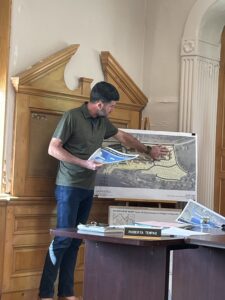SUNY Fredonia students build robots in new course
The future is here

OBSERVER Photos by Mary Heyl. Computer science majors Sammie Huang and Mike Conti completed their robot in Jim Pratt’s Introduction to Robotics course, a new offering at SUNY Fredonia.
When SUNY Fredonia instructor Jim Pratt began planning the Introduction to Robotics course, he knew one of the most important factors would be cost. While certainly a valuable course for preparing students to enter the rapidly changing world of computer technology, a robotics course could be a costly, if not cost-prohibitive, endeavor.
But this semester, Pratt, a pilot by trade, proved that he could teach students how to use an inexpensive, credit-card-sized computer and one of the most in-demand programming languages to design robots that use artificial intelligence to navigate their environment — all for under $300. Not only is this an impressive feat for SUNY Fredonia, but also for the region, as no other college in western New York offers this kind of course in their computer science or computer engineering programs.
Perhaps the only thing more surprising than the affordability of the course is the variety of students who enrolled in it.
“A little more than half are computer science majors, but we have six or seven business majors, a theater major, a history major and a performing arts major who has some impressive wiring skills,” said Pratt of his class of approximately 18 students. “Three or four of these students — business majors — came to the course with no programming skills and haven’t done any wiring since high school. And now they have working, functional robots.”
The course, an elective offered by the Department of Computer and Information Sciences, teaches students the basics of using hardware and software to build simple robots. All semester, students have worked in groups on their robots, and “no two are alike, and there’s no right answer,” according Pratt. Last week, the course culminated in a “robot Olympics challenge” in which students’ robots competed in a basic obstacle course in the hallway of Fenton Hall.

In Fenton Hall, Sammie Huang looks on as her robot makes its way through an obstacle course, the final task in Jim Pratt’s Introduction to Robotics course.
Pratt, who designed the course from scratch, began by teaching students what constitutes a robot, what kinds of robots exist now and the basics of computer hardware circuitry.
Students started with a Raspberry Pi, a basic computer that has almost as much power as a standard laptop computer. “This is the foundation of the robot, and they’re relatively inexpensive — about $40 each. The college provides students with this and the motors, and the students bring the design and wiring to the project.”
A fundamental part of the course is teaching students the programming language called Python. “It’s a very in-demand skill that is essential to AI (artificial intelligence),” Pratt explained. “Python is used a lot in the Silicon Valley.” By using Python, students could control the robot and “teach” it how to react to the environment.
Hunter Danser, a history major, designed a robot that measures distance in four directions, simultaneously, using sensors connected to the motor. “My history classes focus mainly on analysis,” said Danser. “But this course has really taught me a lot about problem solving. What could be causing the robot to move a certain way? How can I adjust the sensors to fix this? These are skills we can definitely take into the real world. We should have more classes like this.”
Computer science majors Mike Conti and Sammie Huang enjoyed the hands-on work of creating their robot, as well as the trial-and-error process involved in making it work. “Negotiating the carpeting and getting it to ‘see well’ have been challenging,” Conti said. “But this is one of the coolest classes I’ve taken.” Conti spent several hours outside of class using a 3D printer to create different pieces for the robot, which ran successfully in the “robot Olympics” last week.

Hunter Danser, a history major, is pictured here with his robot, which uses multiple sensors to detect nearby objects, such as his cell phone, in order to make decisions and self-navigate.
Pratt explained that the course, which also explores the ethics of robotics and artificial intelligence, does not involve a final exam or paper. “If what the students build works, even badly, that’s a success,” he said. “When something doesn’t work, I want the student to be able to identify why it doesn’t work and be able to offer another route to making the project work.”
Indeed, students responded with ideas and solutions right away when their robots tipped over, got stuck or otherwise struggled in the robotics course. “Learning what doesn’t work is merely a step in the process of determining what does work,” said Pratt. “Students doing that will grade well. If they let the problem stall them, that’s where they will lose grade points.”
Both Pratt and Ziya Arnavut, Ph.D., a computer and information sciences professor who attended the robot Olympics, believe that this philosophy and the practical skills gained in the course can prepare students for a range of other courses and careers. “The future of this county and country is technology,” said Arnavut. “We are in great need of people with STEM skills. These are marketable skills that will help our region to grow and attract new industry.”
To Pratt, courses in computer science, including the basics of robotics, are fundamental to preparing students for the not-too-distant future. “In a few years, we’ll probably see a lot of repetitive things being replaced by robots. This is the starting point,” he said.
Pratt believes the course offers students a strong foundation in problem solving, no matter what fields they enter after graduation. “Problem solving, working in teams, research — these are all skills that students are gaining in this course,” he said. “And it’s just plain fun, too!”
Pratt is looking forward to teaching this course again next year and is already brainstorming ideas for a second advanced robotics course.
- OBSERVER Photos by Mary Heyl. Computer science majors Sammie Huang and Mike Conti completed their robot in Jim Pratt’s Introduction to Robotics course, a new offering at SUNY Fredonia.
- In Fenton Hall, Sammie Huang looks on as her robot makes its way through an obstacle course, the final task in Jim Pratt’s Introduction to Robotics course.
- Hunter Danser, a history major, is pictured here with his robot, which uses multiple sensors to detect nearby objects, such as his cell phone, in order to make decisions and self-navigate.









